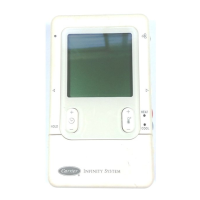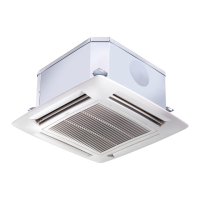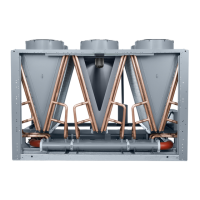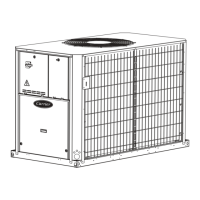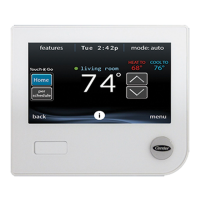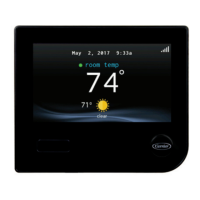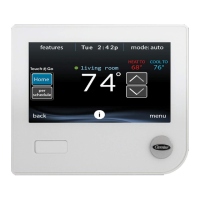If cleaning is necessary, repeat skimming and blowdown procedures above. Usually a long skim is sufficient to clean boiler.
In more troublesome cases, it may be desirable to flush the system as well. This is accomplished by closing gate valve in the Hartford Loop and
opening drain(s) at end of wet return(s). Run a hose from drain valve on wet return to a nearby floor drain or bucket. Run boiler at 2 lb. of steam
pressure. Feed just enough water to compensate for waste condensate going down drain and to keep boiler from going off on low water cut-off.
Run boiler until all waste condensate runs clear.
NOTE: Boiler cleaners and chemical cleaning additives are not recommended. If used and not rinsed properly, they will do more harm than good.
The cleaning procedures laid out above clean out typical oils and impurities found in new boilers and in residential heating systems. The best thing
for boiler and heating system is clean water with no additives.
In very extreme cases, it may be necessary to chemically clean and flush heating system. Consult boiler manufacturer before introducing any
chemicals into boiler.
MAINTAINING BOILER
PROCEDURE 1—WATER LEVEL
Check water level every day or two. Verify water line shown by operating drain valve on gage. BE SURE TOP AND BOTTOM VALVES ON
GAUGE ARE ALWAYS OPEN SO THAT ACTUAL WATER LEVEL IS SHOWN AT ALL TIMES.
The gauge glass should be dry above water line. The water line should not bounce more than about 1 in. when boiler is steaming. If water droplets
carry over through top of gauge glass or excessive bouncing of water line occurs, boiler needs to be cleaned. Follow instructions in Cleaning Boiler
section.
PROCEDURE 2—RELIEF VALVE
Before testing, make certain discharge pipe is properly connected to valve outlet and arranged to contain and safely dispose of boiler discharge.
Under normal operating conditions, a "try lever test" must be performed every month. A "try lever test" must also be performed at the end of any
non-service period. Test at normal system operating pressure by holding test lever fully open for at least 5 sec to flush valve seat free of sediment
and debris. Then release lever and permit valve to snap shut. If lift lever does not activate or there is no evidence of discharge, turn boiler off
immediately and contact a licensed contractor or qualified service personnel.
PROCEDURE 3—LOW WATER CUT-OFF (LWCO)
The low water cut-off interrupts electrical current to burner when water line in boiler drops to a low level.
A. Float-Type Low Water Cut-Offs
It is very important to keep float chamber free of sediment, a condition essential to dependability. To keep any accumulation from interfering with
float action, "blow down" or flush out control regularly. This must be down 2-3 times during the first week after installation and once a week
thereafter during heating season. Do it while boiler is in operation.
1. Note water level in gauge glass.
2. Open blow-off valve at bottom of control. Water will pour out flushing away sediment.
3. Drain until water is clear (about a pailful), then close valve.
4. If water level in gauge glass has dropped, add water to boiler to restore level.
Consult LWCO manufacturer’s instructions included with boiler.
NOTE: Opening blow-off valve checks cut-off operation too. As float drops with falling water level, burners shut off. After valve is closed and
normal operating conditions are restored, burners resume firing.
B. Probe-Type Low Water Cut-Offs
Check action of LWCO monthly to make sure it is providing proper protection. See Checking and Adjusting section. LWCO remote probes must
be removed for periodic inspection and cleaning, preferably at beginning of each heating season. More frequent cleaning may be required on boilers
requiring constant or very frequent additions of water.
PROCEDURE 4—BURNERS
A visual check of pilot and main burner flames should be made at least once each year, preferably at beginning of each heating season. See
Checking and Adjusting section.
PROCEDURE 5—BOILER FLUE PASSAGES
Under normal operating conditions with burners properly adjusted, it should not be necessary to clean boiler flue gas passages. However, to assure
trouble-free operation, we recommend that flue passages, burner adjustment, and operation of controls be checked ONCE EACH YEAR by a
competent service technician.
BEFORE THE START OF EACH SEASON (or whenever system has been shut down for some time), recheck whole system for leaks and recheck
boiler and vent pipe for leaks.
PROCEDURE 6—VENT PIPE
The venting of this unit is very important. Piping should be checked at least once a season. If vent piping shows any signs of leaking, replace it
immediately.
PROCEDURE 7—CLEANING BOILER FLUE PASSAGES AND BURNERS
Flue passages between sections should be examined yearly and cleaned if necessary. To clean:
1. Remove burners, pilot, and vent pipe.
2. Remove top and front jacket panels.
—24—
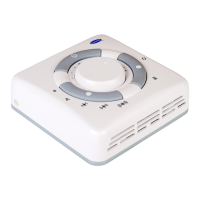
